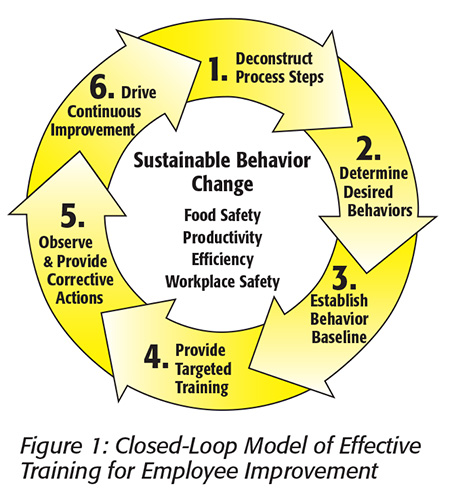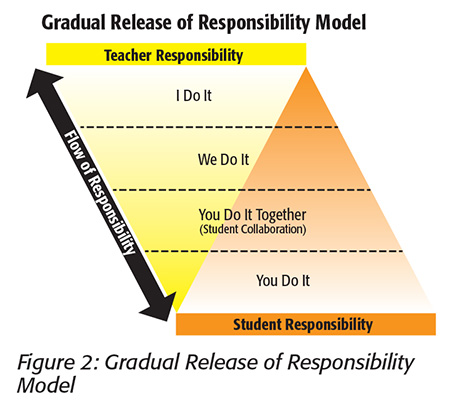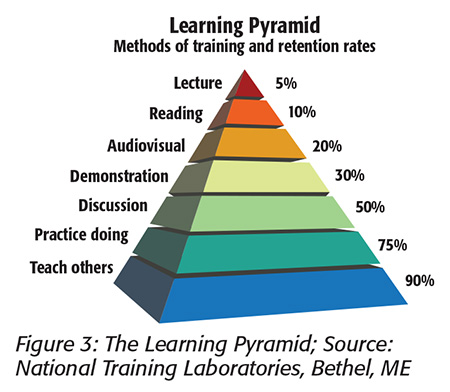Why do we still have such unacceptably high levels of foodborne illness despite the millions of dollars spent to comply with ever-increasing regulations by all segments of the food industry and the millions of dollars spent on university research? Combine these costs with the tax dollars spent to staff and enforce food safety regulations from the local departments of health all the way to the federal government. Could it be that we have reached the point of diminishing returns using these traditional approaches to increase the safety of our food supply?
Why is reducing consumer risk important to you and your company? Let’s start by estimating the annual cost of the impact of foodborne illness each year. A foodborne disease outbreak occurs when two or more people become ill from eating a common food.[1] Hoffman et al.[2] estimated that the annual negative impact of foodborne illness on the U.S. economy ranged from as little as $4.4 billion to as much as $33 billion. In addition to these annual costs, Batz et al.[3] calculated the loss of quality of life to be more than 60,000 quality-adjusted years of life each year in the U.S. alone. Moreover, the monetary cost of a foodborne illness to a family is incalculable. Scharff et al.[4] stated that in addition to not being able to include the costs of human suffering, most of these cost estimates do not include:
• The total costs of the consumers’ medical treatment
• The loss of personal wages
• The cost to the food company to recall the contaminated food products
• Intangibles with real dollar costs like the loss of consumers’ confidence in your company’s brand
• The time you would spend preparing expert testimony in defending against and paying judgments in lawsuits
• The additional costs of the response of regulatory and health agencies to foodborne illness outbreaks
Proper Hand Hygiene
Correctly done when needed, handwashing may be the single most important behavior that can significantly reduce the transmission of foodborne illnesses.[1] Poor personal hygiene on the part of food workers was a contributing factor in roughly 4 out of 10 (38%) foodborne illness outbreaks between 1993 and 1997.[2] The FDA Food Code requires that foodservice workers wash their hands with soap and water, after which they may apply an alcohol-based sanitizer, but sanitizers alone cannot replace handwashing.[1] In a study that observed foodservice workers in restaurants in several states, employees attempted to wash their hands only one-third of the time required by the Food Code, and of those who washed their hands, fewer than one-third washed their hands properly.[3,4] This equates to only one in six successful handwashings when required. In an FDA study of restaurants and retail stores, employee noncompliance with proper and adequate handwashing regulations ranged from about one in four (27%) for elementary school foodservice employees to about three in four (76%) for employees at full-service restaurants.[5] Improved compliance with personal hygiene requirements among food handlers occurred between 1998 and 2008 in retail food facilities, but handwashing practices were the most out-of-compliance risk factor for every type of facility evaluated.[5] In 2008, handwashing practices were not being followed in 76 percent of restaurants and approximately 50 percent of delicatessens.[5] In another study,[6] compliance with Food Code recommendations for frequency of washing during production, service and cleaning phases in restaurants was only 5 percent.
References
1. www.fda.gov/food/guidanceregulation/retailfoodprotection/foodcode/ucm188149.htm.
2. Olsen, S et al. 2000. Surveillance for foodborne disease outbreaks—United States, 1993–1997. Morbid Mortal Weekly Rep 49:1–51.
3. Green, L et al. 2005. Foodservice workers’ self-reported food preparation practices: An EHS-Net study. Int J Hyg Environ Health 208:27–35.
4. Green, L et al. 2006. Food worker hand washing practices: An observational study. J Food Prot 69:2417–2423.
5. www.fda.gov/food/guidanceregulation/retailfoodprotection/foodborneillnessriskfactorreduction/ucm223293.htm.
6. Strohbehn, C et al. 2008. Hand washing frequencies and procedures used in retail food services. J Food Prot 71:1641–1650.
Could it be that in today’s information-rich environment, we have misplaced part of our research emphasis? The data are clear: Despite the growing body of information about the 14 pathogenic bacteria typically associated with food, we have little understanding about how people contaminate food with those bacteria. The bottom line in preventing foodborne illness is in agreement with the tenet that people create the situations that make people sick! Our employees who routinely handle food, many of whom are paid low wages, who may not have been well screened at hiring and may not be properly motivated or well trained, are the root causes of most foodborne illness outbreaks!
Although we are not informed about your company or your employees and cannot prescribe the best practices for your individual situation, this introductory article will provide some well-established employee practices and thought questions. Regardless of your situation, you will be empowered to adapt some of the best training practices for your individual company’s employees.
Taking a Look at Foodservice Employees
When it comes to demographics, more surveys have targeted foodservice employees than employees in the food processing industry. Gould et al.[5] studied 300 foodborne illness outbreaks associated with restaurants during 2006–2007. Their analysis showed that three areas of employee behavior contributed to the majority of the foodborne illness outbreaks:
1) Working sick. Many employees work even when they know they are ill because most hourly food employees do not get paid when they are out sick. Some employers even write policy that tolerates only a specific number of doctor-excused absences. When Carpenter et al.[6] surveyed nearly 500 foodservice workers in nine states, as many as 20 percent of these employees reported working while sick with a potential foodborne illness.
2) Poor personal hygiene. Poor employee hygiene runs the gamut from improper handwashing, personal cleanness, bare-hand contact of ready-to-eat foods or wearing dirty clothes. In research on handwashing, only about one in six times did employees follow proper hand hygiene when it was needed (see “Proper Hand Hygiene”).
3) Inadequate cleaning and sanitizing of food equipment or not following correct food preparation practices. As with most of these reasons, there is definitely an employees’ knowledge component, that is, knowing what behavior is expected and following through with the expected behavior and performing the task as trained. Green and Selman[7] interviewed 70 foodservice workers and found that a majority reported insufficient time and poor equipment design that made proper cleaning difficult. Additionally, they suggested:
• Employees were more likely to handle food in accordance with safe food practices when their managers and coworkers stressed food safety. Thus, there was a company culture of food safety.
• Employees were more likely to safely handle food when they knew there would be immediate, negative consequences for not following prescribed food safety behaviors.
• Firms needed to provide a sufficient number of and readily accessible sinks, well equipped with soap and paper towels. Employees who used gloves increased both handwashing and proper glove use.
• Color-coding utensils and cutting boards helped minimize cross-contamination by keeping raw food preparation surfaces separated from fully cooked food contact surfaces.
• Ready access to thermometers was necessary for employees to measure proper holding, reheating and cooling temperatures—especially in large pans of cooked foods.
• Having well-maintained heating and cooling equipment with sufficient work space surrounding them made it easier for employees to maintain proper heating, cooling and holding temperatures.
• Most regulations mandate food safety education and training. In addition, verification of individual learning and documentation of employees’ application of the training in the work environment are being increasingly required by newer regulations.
• Document, document, document. Managers are under increased accountability to document that each individual employee has received appropriate food safety training and that they are employing proper behavior in the production environment. Automatic or manual documentation needs to be in place to record outputs for Critical Control Points such as end-point temperatures and stored food temperatures.
Creating a work environment that consistently yields safe, unadulterated food is an ongoing challenge for food processors, retailers, restaurants and foodservice employers alike. The food industry spends millions of dollars annually on food safety training, but are its training messages being turned into actions? A colleague recently recounted a story demonstrating the larger issue of creating a culture of safety. While inspecting a manufacturing facility, she noticed a contract worker changing a light bulb in a food plant. The worker was on a 20-foot ladder with his cellphone in one hand, a light bulb in the other hand and his foot dangling precariously off the ladder to reach the light fixture. He was in clear view of all the plant workers, yet not a single person felt obligated to report the incident.[1]
While this incident was disturbing, similar scenarios occur every day in the food industry. So where does the food safety training rubber hit the application road? How do leaders turn food safety training into food safety practice? While there may be many answers to this question, three of the most important are employee comprehension, communication and leaders who are willing to take action.
The average minimum-wage employee handling food has a long list of daily “to-dos” and food safety can easily become just one more thing to do. Explaining why an action must occur rather than demanding unquestioning compliance is the key to achieving consistent execution. Back to our illustration, OSHA rules require workers to maintain three touch points when working on ladders because falls are a leading cause of worker deaths. The rules exist for a reason. Not only is the worker on the ladder responsible for his own actions, but so too are all of his fellow employees.[2]
Comprehension requires an environment that encourages communication from both workers and supervisors. A 2009 study sponsored by the U.S. Department of Agriculture found that participatory workplaces ensure that the individual has a voice, the opportunity to express an opinion that will be heard and the potential to provide an opinion that may make a difference in decision making. Communication can be a formal written directive from management or could be as simple as reminding a food worker to change a dirty apron before beginning a new task. As this same colleague reminded us, complacency is often the death knell of food safety. A strong food safety culture allows open dialogue between management and workers.
While comprehension and communication are cornerstones of an effective food safety program, leadership committed to food safety must come first. The 2009 Peanut Corporation of America peanut butter outbreak that sickened 700 and killed 9 consumers clearly demonstrates this point.[3] Workers recounted stories of “peanut oil left to soak into the floor and the unrepaired roof that constantly leaked rain” and “not a day went by that they didn’t see roaches or rats scurrying about.”[4] No amount of comprehension or communication by the workers could prevent the inevitable outbreak created by apathetic leadership.
Moving food safety training into practice is a challenge that requires many solutions. Continuous commitment to training and communication comes in many forms, and leaders with integrity will continually strive to raise the bar. When I spoke to my colleague recently, she sounded more optimistic. As she walked through the prepared-foods section of the grocery store not long ago, she heard an announcement over the loudspeaker: “All food managers, please grab your thermometers and temp your cold food cases to make sure the food is below 41 °F.” My colleague sighed and said, “At least somebody gets it.”
References
1. ehstoday.com/construction/cdc-there-s-nothing-easy-about-falling-ladder.
2. Novak, JM and TL Sellnow. 2009. Food safety: It’s a talking matter. Communication Currents 4(6).
3. online.wsj.com/articles/head-of-company-that-distributed-salmonella-tainted-peanuts-found-guilty-1411149368.
4. Glanton, D. 2009. “Inside ‘nasty’peanut plant.” The Chicago Tribune February 4.
It is essential that employees be motivated, that proper training of all employees be undertaken and that the results of their training be verified to ensure that each individual employee continues to perform his or her tasks in the prescribed manner to reduce the current, unacceptably high levels of foodborne illness. According to Sprenger,[8] employee training is intended to develop or modify an individual’s knowledge, skills and attitudes through learning experiences with the goal of achieving sustained, effective job performance. However, training employees in a classroom setting where the presenter simply reiterates food safety fundamentals does not produce the best transfer of learning to the work setting. As a prerequisite to learning from their training, employees must be motivated to learn. If each individual employee does not understand that the training to be presented will tangibly help him or her—by providing additional knowledge and/or skills to perform better on their job and be rewarded—then the training will probably not make a long-term change in their behavior (see “Turning Training into Action”).
Implementing and Training: Food Safety Management Systems
“Active Managerial Control” is the term the U.S. Food and Drug Administration (FDA) uses to describe food industry management’s responsibility to develop and implement food safety management systems to reduce consumers’ risk of foodborne illnesses. Routine inspections are designed to identify and require correction of violations at the time of the inspection to ensure basic sanitation, but routine inspections may do little to encourage a company to implement preventive measures. The 2013 Food Code[9] provides additional background for the manager on how to exercise active managerial control by anticipating hazards and conducting risk-based inspections.
Once a company’s management is committed to supporting excellence in employee food safety training, the company will need to decide on foundational learning theories from which to build practical employee training applications, preferably training the employees in the location where the expected behavior will take place.[10,11] Understanding how adults learn best and employing training based on research on adult learning can improve the efficacy of your training.
Let’s explore some of the ways we know your employees learn.
Research findings on how employees learn: Excellent employee training is founded solidly on learning-behavior theories that give the trainer insight into how adults learn. Trainers should compose core food safety learning objectives in the areas of the correct cleaning procedures, steps to prevent cross-contamination, how to determine if a food has been adequately cooked and how to maintain proper temperature control.[12] Employees should be able to demonstrate, in their own working environment, that they can perform the prescribed behavior through practical applications of their knowledge of proper handwashing, good personal hygiene and applying the FDA Food Code and current Good Manufacturing Practices, all of which have been shown to reduce the risk of diseases.[13] Although food safety training may result in an increase in employees’ knowledge about food safety, this knowledge does not always translate into actual practice.[14] As undergraduates in an Introduction to Psychology class, we all heard the dreaded phrase “Take out a sheet of paper and put your name at the top.” Instead of the expected pop quiz, for which we would have been totally unprepared, the class was told to draw a line one inch long. OK, that was easy, but then we were told for the next 10 minutes to “practice drawing lines, each one inch long.” After what seemed like an hour, we were told to stop and the instructor explained the point of the exercise: Practice does NOT make perfect. What we needed was to have a ruler or an example to measure our attempts by in order to get better at freehand drawing a one-inch-long line. Likewise, without a ruler, no amount of practice will enable employees to become more proficient at the expected behavior. Ideally these “rulers” are written, individual key performance indicators (KPIs), which are observable, measurable and prescribed behaviors linked to rewards for both the supervisors on the plant floor and the employees who comply (see “Developing KPIs for Employees”).
Gone, hopefully, are the days of your father’s boss, who was probably a Theory X manager and had a mantra that went something like, “My way or the highway. I’m the boss. You work for me and you ought to be darn thankful you still have a job.” This autocratic management style of the 1960s gave way to the Theory Y management style, which had as its basis that the best plant management can do is provide a structured working environment that guides and rewards employees for working toward the company’s expressed goals.[15] Current management research has demonstrated management practices that lead to higher employee performance. Management helps create an environment where employees are capable of their best sustained performance when:
• Employees possess the abilities, knowledge and skills to perform their jobs at or above expectations;
• Employees are motivated to perform their jobs at or above expectations; and
• Employees are given the freedom and opportunity to do their jobs with minimal distractions.
Lacking any one of these critical components can be harmful or disastrous. A workplace environment dominated by an authoritarian supervisor prevents employees from having the opportunity to use their knowledge and skill. This would particularly be the case if the pressure to produce is so great that employees simply do not have sufficient time to perform at a level that is consistent with their training. While the subject is beyond this current review of best employee training practices, a supportive and engaged style of management will help ensure maximum employee performance.
Two employee learning models: Here are two theoretical learning models that may be applicable to your training situation: the closed-loop model and the gradual release of responsibilities model (GRRM).
 Neal et al.[16] presented the theoretical “closed-loop” learning model designed to improve supervisor-employee communications (Figure 1). The strength of this model is that after training, the supervisor observes employees’ behavior (especially on the just-trained behavior) and provides continual feedback designed to continuously improve employees’ compliance with the expected behavior. Neal’s article has an accompanying case study that can be adapted to your company’s situation to serve as the basis for developing your own training modules with supervisors and employees that uses role-playing situations to address personal hygiene and behavioral issues.
Neal et al.[16] presented the theoretical “closed-loop” learning model designed to improve supervisor-employee communications (Figure 1). The strength of this model is that after training, the supervisor observes employees’ behavior (especially on the just-trained behavior) and provides continual feedback designed to continuously improve employees’ compliance with the expected behavior. Neal’s article has an accompanying case study that can be adapted to your company’s situation to serve as the basis for developing your own training modules with supervisors and employees that uses role-playing situations to address personal hygiene and behavioral issues.
Secondly, perhaps as a manager you would want to consider using the GRRM as a foundation for the initial training of new employees (Figure 2). This model utilizes a subject knowledge expert (SKE), usually a line-lead or supervisor, to model the expected behavior. Advantages of the GRRM include the following:
 • The expert instructor can vary the pace of the material presented based on feedback from the learner and provide the learner an environment of inquiry while encouraging the new learner.
• The expert instructor can vary the pace of the material presented based on feedback from the learner and provide the learner an environment of inquiry while encouraging the new learner.
• With the GRRM, trainees are encouraged to ask questions during the entire training process, and the instructor can use his or her questions to reinforce specific aspects of the training that were unclear while encouraging the learners by respecting questions.
• The instructor can provide feedback on the employees’ performance in the work environment and constructive criticism during the entire process.
The goal is to guide the novice through the stages to become another SKE.
The GRRM follows the learning model that can be put into these lay terms:
1) I do—you watch;
2) You do—I watch (and offer corrections);
3) You do—I observe—a short distance away, allowing you to make mistakes and self-correct them and ask questions on points that are unclear; and
4) The final step: You teach another—I observe your newly trained employees’ behavior. Any of you who have ever been teachers know the effect that teaching a topic has on your mastering the material.
 The GRRM has been shown to be one of the most effective methods to retain learning and forms the “90 percent retention of training” at the base of the learning pyramid (Figure 3).
The GRRM has been shown to be one of the most effective methods to retain learning and forms the “90 percent retention of training” at the base of the learning pyramid (Figure 3).
Some GRRMs have “collaborative (groups) working together during learning” as step 3. For certain ethnic groups, notably Hispanics, the group good and the group goals often supersede individual goals.[17–20]
Adapting Best Practices to Make Long-Term Changes in Employee Behavior
Begin with the end in mind. This quote from Stephen Covey’s best-selling book The 7 Habits of Highly Effective People focuses on at least two fundamental aspects of how to sustain changes in employees’ behavior: Set realistic goals that are understandable to the employees with a realistic timeline for accomplishing them, and write measurable, individual learning objectives that support plantwide goals but are KPIs for an individual’s job responsibilities. There is research to show that high expectations coupled with high “nurture”—care for the employees as persons—increase their commitment to the company’s goals. Extensive research in management shows that setting difficult but achievable goals improves employees’ performance—particularly when employees are more committed (“buy in”) to the goals. We would suggest getting individual employees’ input or at least getting their supervisor involved in writing these KPIs to ensure their buy-in, and you may well be surprised by how resourceful your employees already are. This practice is based on the maxims that “people who set goals achieve more than those who don’t set goals” and “people perform better when they know what’s expected of them.”
Written KPIs allow managers and their employees to track their progress toward a stated strategic goal over a specified period. KPIs can also be used to measure the return on additional resources directed toward accomplishing specific initiatives and to identify areas or approaches for potential improvements.
Keener[1] points out that food processing plant managers often err on both extremes: They fail to fully appreciate the interconnectedness among their five basic food safety programs as a total, all-encompassing safety system, or they pay too much attention to the basic elements of their individual food safety plans and miss the opportunity to maximize their total food safety system’s effectiveness by leveraging across the basic systems. Keener lists the five basic food safety programs with corresponding KPIs for each program that can be used to develop KPIs for your individual employees:
Hazard Analysis and Critical Control Points identify potential risks from hazardous biological, chemical and physical matter, and develop proactive written measures to minimize the risk from each of these hazards in your plant’s environment.
GMPs specify standards of practice for the manufacture, holding and distribution of food as contained in the Code of Federal Regulations, Title 21, Parts 110, 113 and 114.
Regulatory Compliance ensures compliance with local, national and/or international standards as contained in the Federal Food, Drug, and Cosmetic Act, Federal Meat Inspection Act, Egg Inspection Act, Federal Insecticide, Fungicide and Rodenticide Act and the international standards of Codex Alimentarius and the Global Food Safety Initiative.
Quality Control is local, product-specific checks made at the point of production to ensure the production of safe, uniform and consistent foods.
Sanitation Procedures dictate the frequency, protocol and chemicals to be used to clean and sanitize all surfaces in the plant.
Reference
1. www.food-safety.com/magazine-archive1/december-2002january-2003/the-total-plant-food-safety-audit-rating-your-overall-system/.
Help for getting started on writing measurable learning objectives can be found in Kim et al.[21] These authors investigated all the learning objectives from the 2009 FDA Food Code and four online food safety employee training platforms. There were initially more than 250 separate learning objectives from these four sources that were then screened using an expert panel down to 75 baseline learning objectives for new employees working in the retail deli environment. Kim et al.21 explain how you can use the Delphi technique to build consensus among your managers, supervisors and employees on what needs to be taught.
You may be considering augmenting your current face-to-face training program with an online or Web-based employee training to save staff time by complementing what you are currently doing. Neal et al.[22] have developed an assessment tool to help managers compare the potential effectiveness of the many online training programs with the needs of your company. Before purchasing any new safety training software, managers must first identify what are the knowledge components that need to be included in their specific employee food safety training programs. Remember, the goal is to buy a training system that not only educates your employees but also produces sustained changes in their behavior.
Reduce employee turnover to a minimum. Spending money on training your new employees who then go work for someone else is not a sustainable business practice. To minimize your employee turnover, start by getting unwavering support from plant and senior management, and then begin working with your human relations (HR) professionals to collect relevant baseline data for your plant. Get hard numbers on:
• What are the current and past trends in employee turnover?
• Are there certain departments or shifts that stand out as having unusually high (or low) employee turnover rates?
• What past HR practices have been effective in reducing employee turnover?
• Working with plant managers, how would you classify these separations by cause? What was the underlying reason the employee was terminated? Are employees quitting? Are they getting fired? Are the ones getting fired doing so because they lack knowledge or skills that could have been provided by timely training? Are they getting fired because they lack abilities that should have been screened out in the hiring and selection process? Understanding the cause for the separation is vital to your proposed solution to unacceptably high employee turnover.
• What HR practices do other food manufacturers in your area or similar types of manufacturers have in place to reduce their employee turnover?
A just-completed nationwide study of foodservice employees focused on minimizing employee turnover where the typical hourly employee is 24 to 32 years of age.23 Projecting these published employee turnover costs to estimate employee turnover for an example company with 500 employees means for this example plant that the average employee turnover rates added more than $300,000 to the bottom-line costs every year! These are dollars that could be used for additional employee training or incentive rewards. In the foodservice industry, Group A managers, who typically invested 1 week or less in their employee training, had hourly employee turnover rates in the 40 to 50 percent range, which almost guaranteed no employee tenure was longer than 4 years. Group B managers at companies with the highest HR investments were able to cut their employee turnover rates in half, to 26 percent, and extended the average employee tenure to more than 6 years with corresponding cost savings.
Ways to minimize your employee turnover:
• Invest in appropriate employee training—demonstrate you care for each employee individually (nurture them) by providing them the training they need to do a first-class job.
• Pay a higher-than-competitive wage—this salary premium may more than pay for itself in savings from employee turnover. You will need to start collecting information on employee turnover to substantiate this point with your plant’s management. Think about this from an economist’s point of view as an “efficiency wage,” which, when properly implemented, will increase both the likelihood you’ll get a larger number of more experienced applicants (possibly leaving someone else’s employment) to select from for each of your job openings, and secondly, you’ll be more likely to keep and grow the employees’ talent you currently possess.
• Allow for more discretion for trained employees to make decisions that affect their work. These are the “opportunities” we wrote about earlier, where once employees are trained and have demonstrated proficiency, they can discuss their ideas to make the product and working conditions better. Almost everyone appreciates your asking for their opinions.
• Promote from within—have a clear path for all levels of advancement and make every employee aware of their opportunities.
On this last point, in talking with a midlevel manager at a major food company about possible managerial openings for one of our students, his response was, “I have dozens of plants and hundreds of employees. If I am not able to provide the training opportunities so that I can hire capable managers from within, then I’m not doing my job.” He makes a good point!
Know the costs involved. In research we have just completed, we conducted a study of employee training costs for Midwestern and West Coast plants where we were able to estimate the magnitude of these company’s commitment of resources required to train their employees.24 Adapting their cost figures from these two plants to our 500-employee example plant, an estimate for the minimal training costs, using only one trainer, and large class sizes of 50 employees per class would require 10 class sessions (to include all employees) per year per training topic. If class sizes that were half that number, 25 employees, it would require 20 class sessions per year per training topic. For these two plants, their current, estimated annual training time commitment was 30 hours per year for every individual employee. Using an average employee’s salary at $14/hour, the cost for these 30 hours of training would total $420/year/employee for training. This equates to an annual investment of more than $200,000 just in employees’ salaries (500 employees at $420/year = $210,000). However, management must also budget for additional costs, which include the supervisors’ time in preparing and giving the training, rooms and training supplies. Remember, minimizing your employee turnover will go a long way in paying for these employee training costs and purchasing professionally made training materials.
Quantify the cost/benefits of employee training. This information will do much to maintain upper-level management support for continually funding the training program you have worked so hard to put in place. The best measure of whether employee behavior is complying with the best recommended practices comes from observing individual employees at work applying safe behaviors. In a recent study, observations were made of employees as they performed routine food handling practices. Observations, video recordings and the use of fluorescent powder were used to identify possible cross-contamination points.[25] This study was able to identify “high-contact” points for likely cross-contamination that needed to be scheduled for greater-than-routine surface sanitation, and the residual fluorescent powder provided a stark demonstration of cross-contamination to the learners.
Select the right method. Most of the regulatory policies on employee training are sufficiently broad to permit managers the needed flexibility to apply their knowledge of their particular plant environment to select appropriate training methods and times for their employees. However, it is vital that each manager knows what employee training and verification the regulators and customers require, then measure, the return on investment from additional training beyond what is required. Consultants or published sources can provide detailed information that can be adapted for your individual plant’s training program. Sources for additional information on requirements for employee training can be found in the Food Safety Modernization Act, which considers employee training as a preventive control to be implemented by plant management,[26–28] and the Global Food Safety Initiative.[29–31]
Conclusions
Each of us has a responsibility to protect the safety of consumers, protect the goodwill and reputation of the food industry and comply with the letter and spirit of food safety regulations. Hiring the best employees available, motivating and training them properly and verifying that they are complying with the prescribed behavior will make our great food supply even better.
We thank Laura Dunn Nelson, vice president, business development and professional services at Alchemy Systems, and Francie Buck, global food safety manager at Sealed Air, for assisting in this article.
Philip G. Crandall, Ph.D., works in the Center for Food Safety and food science department at the University of Arkansas.
Corliss A. O’Bryan, Ph.D., works in the Center for Food Safety and food science department at the University of Arkansas.
Jay Neal, Ph.D., works in the Conrad N. Hilton College of Hotel and Restaurant Management at the University of Houston.
John E. Delery, Ph.D., is a professor and endowed chair in management at the University of Arkansas.
References
1. www.cdc.gov/features/dsfoodborneoutbreaks/.
2. Hoffmann, S et al. 2012. Annual cost of illness and quality-adjusted life year losses in the United States due to 14 foodborne pathogens. J Food Prot 75:1292–1302.
3. Batz, MB et al. 2012. Ranking the disease burden of 14 pathogens in food sources in the United States using attribution data from outbreak investigations and expert elicitation. J Food Prot 75:1278–1291.
4. Scharff, RL, J McDowell and L Medeiros. 2009. Evaluation of an educational intervention using the enhanced food safety cost-of-illness model. J Food Prot 1(72):137–141.
5. Gould, LH et al. 2013. Contributing factors in restaurant-associated foodborne disease outbreaks, FoodNet Sites, 2006 and 2007. J Food Prot 76:1824–1828.
6. Carpenter, LR et al. 2013. Food worker experiences with and beliefs about working while ill. J Food Prot 76(12):2146–2154.
7. Green, L & C Selman. 2005. Factors impacting food workers’ and managers’ safe food preparation practices: A qualitative study. Food Prot Trends 25:981–990.
8. Sprenger, RA. 2009. Hygiene for Management, 15th ed. South Yorkshire, UK: Highfield Publications, p. 150–151.
9. www.fda.gov/downloads/Food/GuidanceRegulation/RetailFoodProtection/FoodCode/UCM374510.pdf.
10. Rennie, DM. 1994. Evaluation of food hygiene education. Brit Food J 96:20–25.
11. Taylor, E. 1996. Is food hygiene training really effective? Environ Health September:275–276.
12. www.who.int/foodsafety/consumer/5keys/en/.
13. Xavier, CAC et al. 2007. Prevalence of Staphylococcus aureus in food handlers from grade schools located in Natal city, RN, Brazil. Brazilian Mag Clin Anal 39:165–168.
14. Wie, SH and CH Strohbehn. 1997. The impact of a sanitation food safety course on attitudes and knowledge of hospitality students. J Hospitality Tourism Educ 9:65–73.
15. www.economist.com/node/12370445.
16. Neal, JA et al. 2014. Preventing post-processing contamination in a food nugget processing line when language barriers exist. J Agric Food Anal Bacteriol 4:20–26.
17. Cho, S et al. 2010. Changing Food Safety Behavior among Latino(a) Food Service Employees; The Food Safety Belief Model. International CHRIE Conference, San Juan, Puerto Rico.
18. Neal, JA et al. 2011. Identifying food safety concerns when communication barriers exist. J Food Sci Educ 10:36–44.
19. Neal, JA. 2013. Comparative analysis of training delivery methods for new employees cleaning and sanitizing retail deli slicers: An exploratory study. Food Contr 23:149–155.
20. Nieto-Montenegro, S et al. 2008. Development and assessment of pilot food safety educational materials and training strategies for Hispanic workers in the mushroom industry using the Health Action Model. Food Contr 19:616–633.
21. Kim, KK et al. 2013. Identifying baseline food safety training practices for retail delis using the Delphi expert consensus method. Food Contr 32:55–62.
22. Neal, JA et al. 2011. Development of an evaluation tool for online food safety training programs. J Food Sci Educ 10:9–12.
23. rocunited.org/wp-content/uploads/2014/01/HRPTCS_Cornell_Report_4.pdf.
24. Crandall, PG. In press.
25. Gibson, KE et al. 2013. Observation and relative quantification of cross-contamination within a mock retail delicatessen environment. Food Contr 31:116–124.
26. www.fda.gov/Food/GuidanceRegulation/FSMA/ucm284406.htm.
27. www.fda.gov/Food/GuidanceRegulation/FSMA/ucm256826.htm.
28. www.iit.edu/ifsh/alliance/.
29. www.22000-tools.com/GFSI.html.
30. www.mygfsi.com/schemes-certification/certification/how-to-achieve-certification.html.
31. Crandall, PG et al. 2012. Companies’ opinions and acceptance of global food safety initiative benchmarks after implementation. J Food Prot 75(9):1660–1672.




